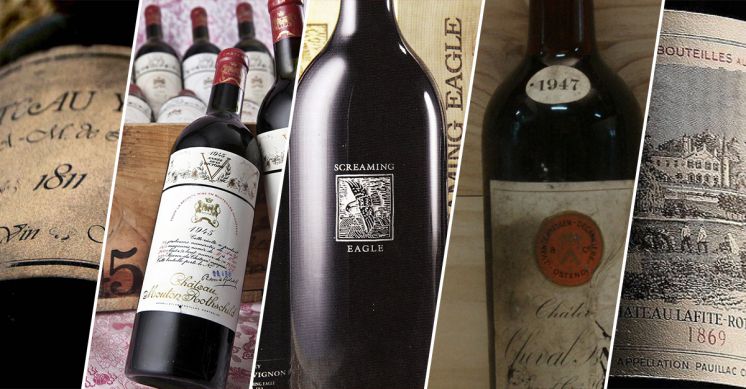Rare and expensive wines captivate wine lovers and collectors thanks to their exclusivity, history and exceptional quality. These bottles embody prestige, ancestral know-how and viticultural excellence.
What makes wine so expensive?
1. Limited production
Wineries producing rare and expensive wines deliberately limit quantity to guarantee impeccable quality.
- Example: Domaine de la Romanée-Conti, with extremely low yields.
2. Age and vintage
Vintage grands crus from exceptional harvests increase in value over time.
- Key factors: Ideal climatic conditions, special care given to the vines.
3. A worldwide reputation
The most prestigious estates boast a rich history and generations of recognized expertise.
- For example: Château Lafite Rothschild and Château Margaux, synonymous with excellence.
4. Demand outstrips supply
The rarity of these wines attracts collectors willing to pay astronomical sums to own a unique bottle.
The most prestigious wines and their history

1. Domaine de la Romanée-Conti (France)
- Average price: Several tens of thousands of euros per bottle.
- Particularity: This Burgundian Pinot Noir is produced in limited quantities on a 1.8-hectare plot.
2. Château Lafite Rothschild (France)
- Average price: Up to €20,000 for certain vintages.
- Particularity: One of Bordeaux's five premier grands crus classés, renowned for its elegance and longevity.
3. Screaming Eagle (United States)
- Average price: Over €10,000 for recent vintages.
- Distinctive features: This Napa Valley Cabernet Sauvignon stands out for its ultra-confidential production.
4. Cheval Blanc (France)
- Average price: Around €7,000 for an exceptional vintage.
- Distinctive features: Located in Saint-Émilion, this estate produces complex, well-balanced wines.
5. Penfolds Grange (Australia)
- Average price: €500 to €1,000 for recent vintages, but some reach several thousand.
- Special features: A symbol of Australian wines, made from Shiraz with a touch of Cabernet Sauvignon.
Factors influencing the price of vintage grands crus
1. Exceptional terroir
Prestigious wines often come from renowned wine-growing regions. These unique terroirs contribute to incomparable flavors.
- Example: Burgundy's limestone soil favors wines of great finesse.
2. Traditional methods
High-end estates adopt rigorous, environmentally-friendly viticultural practices.
- Example: Harvested by hand, aged in new oak barrels.
3. Certification and grading
Official classifications, such as those of Bordeaux in 1855, reinforce the value of certain rare and expensive wines.
- Example: Les Premiers Grands Crus Classés in Bordeaux.
4. Influence of auctions
Auctions often increase the value of historic bottles or rare vintages.
- Example: A bottle of Romanée-Conti 1945 sold for over €500,000.
Tasting a prestigious wine: a unique experience
1. Prepare the bottle
Leave the wine to rest after transport to avoid suspended deposits.
2. Decanting vintage wines
Aged wines benefit from aeration to release their complex aromas.
3. Serve at the right temperature
Observe the ideal temperatures:
- Reds: 16-18 °C.
- Whites: 10-12 °C.
4. Use appropriate lenses
Choose tulip-shaped glasses to concentrate aromas for optimal tasting.
Rare wine and food pairings
1. Red meats and game
Red vintage wines, such as Château Margaux, go well with refined meats.
- Pairing example: Filet of beef en croûte with a Bordeaux wine.
2. Fish and seafood
Prestigious white wines, like a Montrachet, go well with noble fish and shellfish.
- Pairing example: Grilled lobster with a Burgundy Chardonnay.
3. Ripened cheeses
Sweet or syrupy wines complement the flavors of strong cheeses.
- Pairing example: Roquefort with Sauternes.
Mistakes to avoid with prestigious wines
1. Consuming them too young
Some vintage grands crus require several years of ageing before reaching their peak.
2. Serving them in poor conditions
Poorly stored wine, or wine served at the wrong temperature, loses its taste value.
3. Neglecting conservation details
Store bottles horizontally, in a cool, dark place, to preserve their quality.
Trends in rare and expensive wines
1. Interest in biodynamic wines
Some prestigious estates adopt biodynamic practices to enhance the authenticity of their wines.
2. Online auctions
Digital platforms facilitate access to rare and expensive wines, even for private individuals.
3. Exclusive experiences
Many estates offer private tours and tastings to discover their treasures.
Conclusion: a plunge into the world of luxury winegrowing
Prestigious wines embody the excellence and passion of the winegrower's craft. Whether they come from legendary terroirs or small-scale artisanal production, they fascinate by their quality, history and rarity. If you're a lover of rare and expensive wines, take the time to savor them in ideal conditions to appreciate their true value.
If you enjoyed this article, you may also be interested in "How to combine wine and cheese for an optimal taste experience"!





